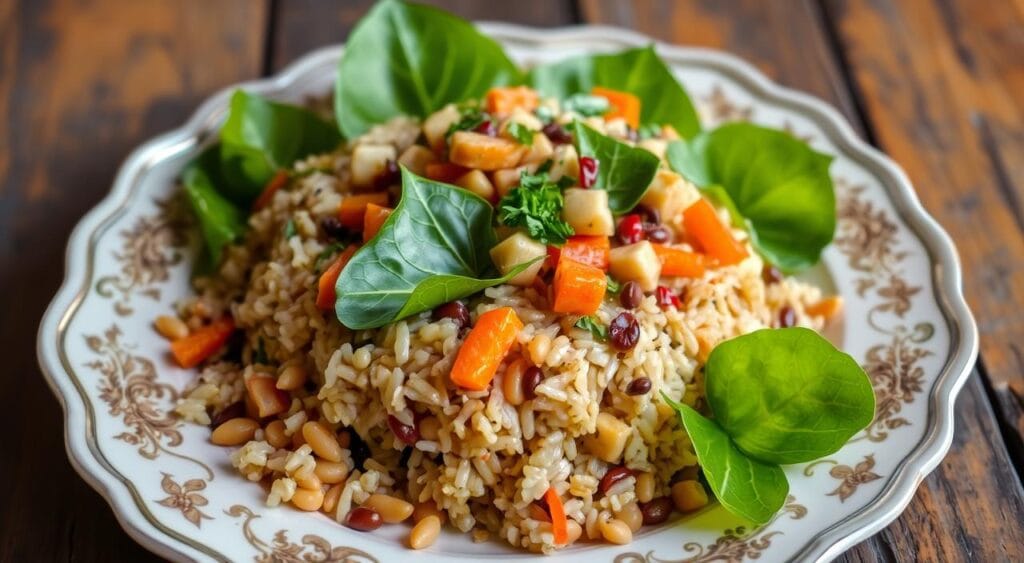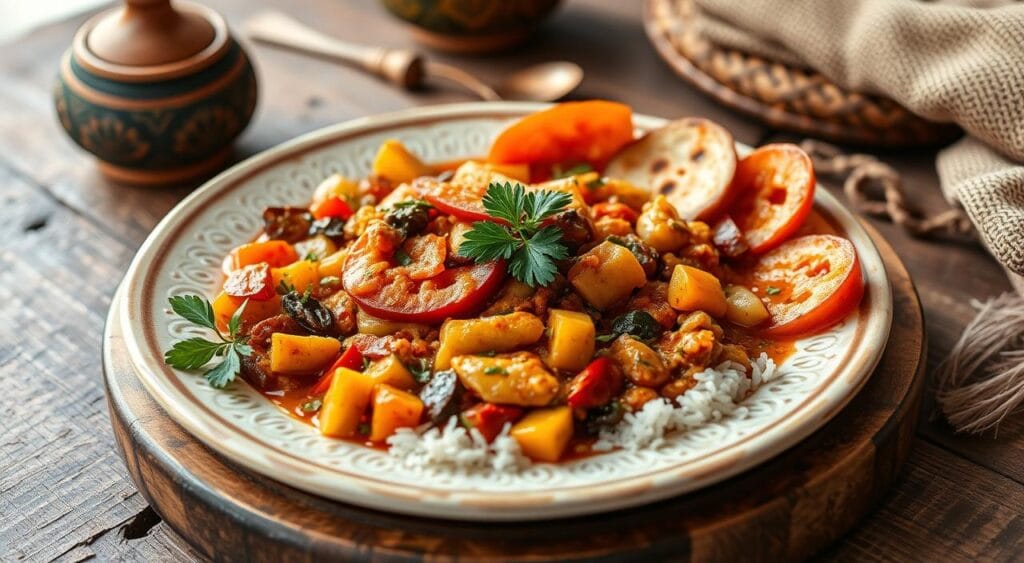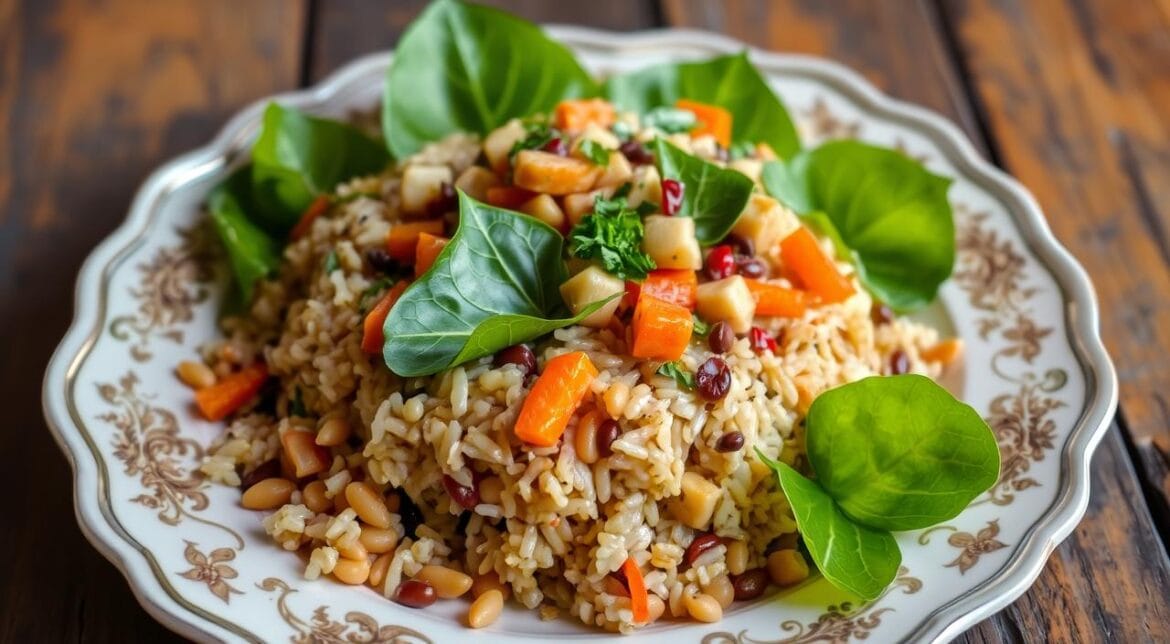Table of Contents
Exploring Indonesian cuisine can be thrilling and a bit scary for newcomers. But, with the right help, you can quickly learn to make sajata. This guide will show you the must-have ingredients, tools, and steps to make real sajata at home.

Key Takeaways
- Understand the cultural significance and origins of the traditional sajata dish
- Discover the key ingredients and essential equipment needed to prepare sajata
- Learn the basic steps to create a classic sajata recipe for beginners
- Explore vegetarian, vegan, and gluten-free sajata variations
- Gain time-saving tips and techniques to master the art of sajata making
Understanding Sajata: Traditional Origins and Cultural Significance
Sajata is a cherished dish in Indonesian cuisine with a deep history and cultural importance. It has evolved over time but keeps its core essence. This savory dish is rooted in the diverse culinary traditions of Indonesia.
Historical Background of Sajata
The history of sajata goes back centuries. It has been a staple in Indonesia for generations. Traditional sajata dish comes from the island’s indigenous communities. They created unique flavors and cooking methods that have been passed down.
Cultural Importance in Regional Cuisine
In Indonesia, sajata regional variations are key to local food traditions. From North Sumatra’s fragrant versions to East Java’s spicy ones, each sajata reflects its region’s unique flavors and influences.

Modern Adaptations and Popularity
Recently, sajata’s appeal has led to new adaptations. Chefs and home cooks have mixed traditional recipes with modern flavors and styles. This keeps the dish fresh and appealing to today’s tastes.
“Sajata is more than just a dish – it’s a tapestry of Indonesia’s culinary heritage, woven with the threads of regional identity and cultural tradition.”
The growing popularity of traditional sajata dish and sajata regional variations shows its cultural significance. It highlights Indonesia’s rich diversity and enduring traditions in cuisine.
Essential Ingredients for Perfect Sajata
Making a real sajata dish needs the right ingredients. These ingredients give it a special sajata flavor profile. Each part adds to the mix, making the flavors just right. Let’s look at what makes a sajata stand out.
Spices and Seasonings
The heart of sajata’s taste comes from spices and seasonings. A mix of cumin, coriander, and turmeric is key. They bring a warm, earthy taste. Ginger and garlic add depth and complexity.
Fresh Produce
Sajata recipes use fresh veggies for texture and taste. Sajata ingredients often include onions, tomatoes, bell peppers, and leafy greens like spinach or cilantro. Using them right makes the flavor balanced and vibrant.
Protein Sources
Sajata ingredients can be meat like chicken or lamb. But there are also tasty veggie and vegan options. Chickpeas, lentils, and paneer (fresh Indian cheese) are great for adding protein.
Dairy and Acidity
Dairy like yogurt or cream adds a creamy touch. A bit of lemon juice or vinegar brings a nice acidity. This brightens the whole dish.
| Key Sajata Ingredients | Flavor Contribution |
|---|---|
| Cumin, Coriander, Turmeric | Earthy, Warm, Pungent |
| Ginger, Garlic | Depth, Complexity |
| Onions, Tomatoes, Bell Peppers | Vibrant, Well-Balanced |
| Yogurt, Cream | Creamy Texture |
| Lemon Juice, Vinegar | Welcomed Acidity |
Choosing and mixing these sajata ingredients carefully makes a dish that truly shows off the sajata flavor profile. Knowing these key parts helps you master making perfect sajata.
Basic Kitchen Tools and Equipment Needed
To make traditional sajata, you need some basic kitchen tools and equipment. Whether you’re new to cooking or have experience, the right tools make cooking easier and more fun. Let’s look at the essential utensils, optional advanced tools, and storage solutions for successful sajata making.
Must-Have Utensils for Sajata Preparation
- Sharp chef’s knife or santoku knife for chopping vegetables and proteins
- Cutting board, preferably made of wood or plastic, for safe food preparation
- Measuring cups and spoons to accurately portion ingredients
- Mixing bowls of various sizes for combining ingredients
- Spatula or wooden spoon for stirring and sautéing
- Colander or strainer for rinsing and draining cooked ingredients
Optional Equipment for Advanced Sajata Preparation
While basic utensils are key, some extra equipment can enhance your sajata cooking:
- High-quality blender or food processor for smooth sauces and marinades
- Pressure cooker or Instant Pot for quick and tender cooking
- Wok or large skillet for authentic stir-frying
- Steamer basket or insert for healthy vegetable preparation
Storage Containers and Serving Dishes for Sajata
After cooking your sajata, you’ll need the right storage and serving options:
- Airtight containers or meal prep containers for leftover sajata
- Serving platters or bowls for a nice presentation
- Reusable chopsticks or forks for a traditional dining experience
Investing in these kitchen tools and equipment will help you master sajata cooking. From basic to advanced techniques, and proper storage and serving, you’ll enjoy your homemade sajata fully.
Classic Sajata Recipe for Beginners
Starting your sajata cooking journey is exciting. A classic recipe is a great way to begin. This guide will help you make a delicious sajata dish on your first try.
To make a perfect sajata recipe, you need some key ingredients and tools. First, prepare your ingredients carefully. Then, start cooking using the sajata cooking method.
- Begin by cooking your aromatic base. This includes onions, garlic, and spices like cumin and coriander. It sets the dish’s flavor.
- Then, add your protein, like chicken, beef, or a plant-based option. Let it brown for a tasty crust.
- Add diced veggies, like tomatoes, bell peppers, and potatoes. Let them cook until they’re tender.
- Now, mix in your flavorful liquid. This could be broth, diced tomatoes, and sajata seasonings. Simmer until the sauce thickens.
- Finish with fresh herbs, toasted nuts, or yogurt. This adds elegance and balances the flavors.
The secret to a great sajata recipe is in the prep and seasoning. Follow this classic method to become a sajata master. You’ll impress everyone with your tasty dishes.
“Cooking is like painting or writing a song. “Just like there are a limited number of notes or colors, there are only so many flavors – it’s the way you combine them that makes you unique.” – Wolfgang Puck
Vegetarian and Vegan Sajata Variations
Plant-based living doesn’t mean giving up on sajata’s tasty flavors. There are many vegetarian and vegan sajata options. These let you enjoy this favorite dish while following your diet.
Plant-Based Protein Options
For vegetarian and vegan sajata, finding good protein sources is key. Here are some great options:
- Tofu or tempeh for a high-protein, versatile base
- Lentils or chickpeas for a hearty, fiber-rich addition
- Mushrooms, such as portobello or shiitake, for their savory, umami-rich flavor
- Nuts and seeds, like almonds or pumpkin seeds, to add crunch and texture
Seasonal Vegetable Combinations
Using fresh, seasonal produce makes vegetarian and vegan sajata dishes vibrant and tasty. Try adding a mix of colorful vegetables, like:
- Roasted sweet potatoes or butternut squash add a delightful touch of sweetness.
- Sautéed bell peppers and onions for a classic flavor base
- Tender greens like spinach or kale for a nutrient-dense boost
- Seasonal vegetables like zucchini, eggplant, or bell peppers to highlight the best of the season
Vegan Sauce Alternatives
For flavorful and creamy vegetarian or vegan sajata, try these sauces:
- Cashew-based sauces for a rich, dairy-free creaminess
- Coconut milk or coconut cream for a subtle tropical twist
- Nut butters, like almond or peanut, to add a nutty depth of flavor
- Boldly spiced tomato-based sauces for a zesty, aromatic experience
With these plant-based protein sources, seasonal produce, and tasty sauces, you can enjoy many vegetarian and vegan sajata dishes. They’re just as good as the traditional ones. Get creative in the kitchen and find new ways to enjoy this beloved dish while meeting your dietary needs.
Gluten-Free Sajata Options and Substitutions
Living gluten-free doesn’t mean missing out on sajata‘s great taste. With smart swaps and tweaks, you can enjoy gluten-free sajata just as much. Let’s dive into making gluten-free sajata that’s both tasty and safe for everyone.
Flour Alternatives for Gluten-Free Sajata
The base of sajata is flour, and for gluten-free, you have many choices. Here are some great options:
- Rice flour – Easy to find and works well in sajata recipes.
- Almond flour – Adds a nutty taste and soft texture to sajata.
- Chickpea flour – Known as besan, it brings a rich flavor to sajata.
- Coconut flour – A low-carb choice that makes sajata light and sweet.
Remember, each flour absorbs liquid differently. Adjust your sajata ingredients to get the right mix.
Binding Agents for Gluten-Free Sajata
To keep your gluten-free sajata together, use binders like:
- Ground flaxseed or chia seeds – They’re good for binding and add nutrients.
- Xanthan gum – A little goes a long way in making sajata batter stick together.
- Arrowroot powder – This thickener makes your gluten-free sajata smooth and cohesive.
“Embracing a gluten-free lifestyle doesn’t mean you have to forgo the delightful flavors of traditional sajata.”
Time-Saving Tips and Preparation Techniques
Efficiency is key when making delicious sajata. Smart preparation and make-ahead components can save you time. Learn these tips to master the sajata cooking method.
Prep Work Strategies
Start by chopping, dicing, and measuring ingredients early. This mise en place method makes cooking smoother and prevents forgetting important parts. Also, pre-cook rice or lentils to reheat later.
Make-Ahead Components
- Make the sajata sauce or marinade ahead and keep it in the fridge for up to 3 days.
- Cook the protein, like chicken or tofu, and keep it separate for the final dish.
- Chop and store veggies or herbs before time.
Storage and Reheating Guidelines
Proper storage keeps your sajata fresh. Keep it in an airtight container in the fridge for up to 3 days. To reheat, use the stovetop or microwave with a bit of water or broth.
| Preparation Technique | Benefit |
|---|---|
| Mise en place | Ensures a smooth cooking flow and reduces the risk of forgetting critical ingredients. |
| Pre-cooking components | Saves time on the day of serving and allows for easy reheating. |
| Proper storage and reheating | Maintains the quality and freshness of the sajata dish. |
Use these tips to improve your sajata cooking. Enjoy delicious, stress-free meals with ease.
Common Mistakes to Avoid When Making Sajata
Making the perfect sajata recipe is a fun journey. However, it also comes with its own set of challenges. Being aware of common mistakes can help you steer clear of them. We’ll look at the top mistakes and give you tips for success.
One big mistake is using the wrong ingredients or the wrong amounts. It’s key to have the right mix of spices and herbs for the true sajata taste. Always check the recipe and adjust as you like.
- Avoid over-seasoning or under-seasoning your sajata.
- Make sure to use fresh, high-quality ingredients for optimal results.
- Be mindful of the cooking time and temperature to prevent overcooking or undercooking your sajata.
Another mistake is not preparing ingredients well before cooking. Good prep work, like chopping or marinating, greatly improves your sajata’s taste and texture. Spend time on prep for a smooth cooking process.
“The key to a successful sajata dish lies in the attention to detail during the preparation stage.”
Lastly, wrong storage and reheating can ruin your sajata. Always store leftovers right and reheat carefully to keep it fresh and tasty.
By watching out for these mistakes and using the right methods, you’ll get better at sajata cooking. You’ll make dishes that wow your loved ones.
Sajata Recipe Variations by Region
Sajata is loved for its many regional flavors across Indonesia and beyond. Each place has its own special taste, ingredients, and cooking ways. These differences make sajata a true culinary treasure.
Northern Style Adaptations
In Indonesia’s north, sajata is bold and aromatic. Spices like lemongrass, galangal, and kaffir lime give it a unique flavor. Coconut milk makes it creamy, and turmeric adds a bright yellow color. These variations are known for their complex tastes and beautiful looks.
Southern Flavor Profiles
In Indonesia’s south, sajata is more intense and pungent. It has lots of shrimp paste, chili peppers, and tamarind for a tangy, spicy taste. Vegetables like water spinach and long beans add texture and freshness. These versions are loved for their bold flavors.
International Fusion Ideas
The world’s connection has made sajata popular outside Indonesia. Chefs and cooks mix sajata with different cuisines. They put it on vegetables, in pasta dishes, or on rice bowls. These fusions show sajata‘s adaptability and appeal worldwide.
“The beauty of sajata lies in its ability to transcend borders and cultures, offering a taste of Indonesia’s rich culinary heritage to the world.”
Nutritional Benefits and Health Considerations
Sajata is a traditional dish loved by many. It not only tastes delicious but also offers numerous health benefits. It’s a good source of important nutrients, making it a great choice for a healthy diet.
Sajata is made of carbs, proteins, and fats. The carbs give you energy. The proteins help build and repair muscles. The fats are good for your heart and help you absorb vitamins.
| Nutrient | Amount per Serving | % Daily Value |
|---|---|---|
| Calories | 250 kcal | 12.5% |
| Carbohydrates | 35 g | 12% |
| Protein | 12 g | 24% |
| Total Fat | 8 g | 12% |
| Dietary Fiber | 6 g | 21% |
| Vitamin A | 120 mcg | 13% |
| Vitamin C | 15 mg | 17% |
| Iron | 3 mg | 17% |
Sajata is also packed with vitamins and minerals. It has antioxidants from veggies, herbs, and spices. These help boost your immune system and fight off diseases.
Eating sajata can improve your digestion and heart health. It also strengthens your immune system. The fiber in sajata helps control blood sugar and keeps you full, aiding in weight management.
But, it’s key to think about your own diet and health needs. Talking to a doctor can help you add sajata to your diet in the best way. In this way, you can fully enjoy its health benefits.
Conclusion
In this guide, we’ve looked into the rich history and cultural importance of sajata. We’ve also explored its delicious flavors. You now know how to make this traditional Indonesian dish.
Sajata is great because it fits many diets, from classic to vegetarian and gluten-free. This guide has given you the tools to try new recipes and enjoy sajata’s true taste.
Now, start your sajata journey and enjoy the process. Celebrate the variety of flavors and share this dish with loved ones. Let your taste buds guide you as you explore this amazing traditional Indonesian dish.
FAQ
What is sajata?
Sajata is a traditional Indonesian dish from Javanese cuisine. It’s a savory stir-fry with vegetables, protein, and a tasty sauce.
What are the main ingredients in sajata?
Key ingredients include shallots, garlic, chili peppers, and sweet soy sauce. Chicken, beef, or tofu are the proteins. Cabbage, bean sprouts, and carrots are common veggies.
How do you cook sajata?
Cook sajata by stir-frying in a wok or skillet over high heat. First, cook the veggies, then the protein, and finally add the sauce.
Is sajata a vegetarian or vegan dish?
Yes, sajata can be vegetarian or vegan. Use tofu or tempeh for protein in vegetarian versions. Vegan sajata omits animal products and uses plant-based ingredients.
Can sajata be made gluten-free?
Absolutely, sajata can be gluten-free. Substitute regular soy sauce with tamari or coconut aminos. Make sure all ingredients, including thickeners, are gluten-free.
What are the health benefits of sajata?
Sajata is healthy because it’s full of veggies and can be a good protein source. It’s low in fat and calories, great for a balanced diet.
Are there regional variations of sajata?
Yes, sajata varies by region in Indonesia. Northern versions might include seafood, while southern ones focus on spices and veggies. Fusion recipes with international flavors are also popular.


1 comment
[…] Posts How to make simple dishes with Sajata recipe… Easy Sajata recipe ideas for beginners Recipe for Crumpets with Caviar: A Gourmet Twist… Crumpet Recipe from Great British Chefs: A […]
Comments are closed.